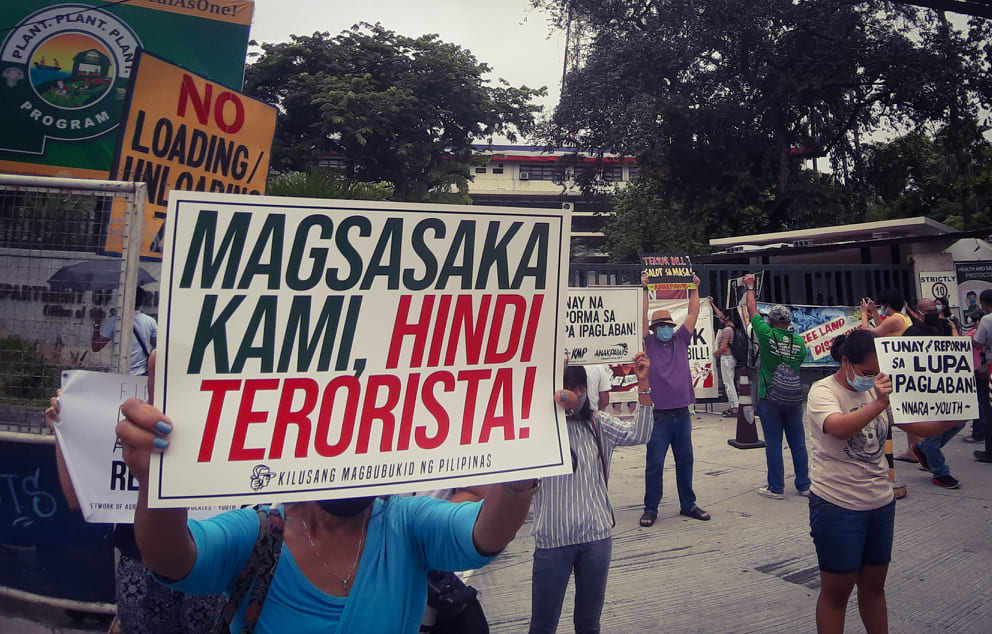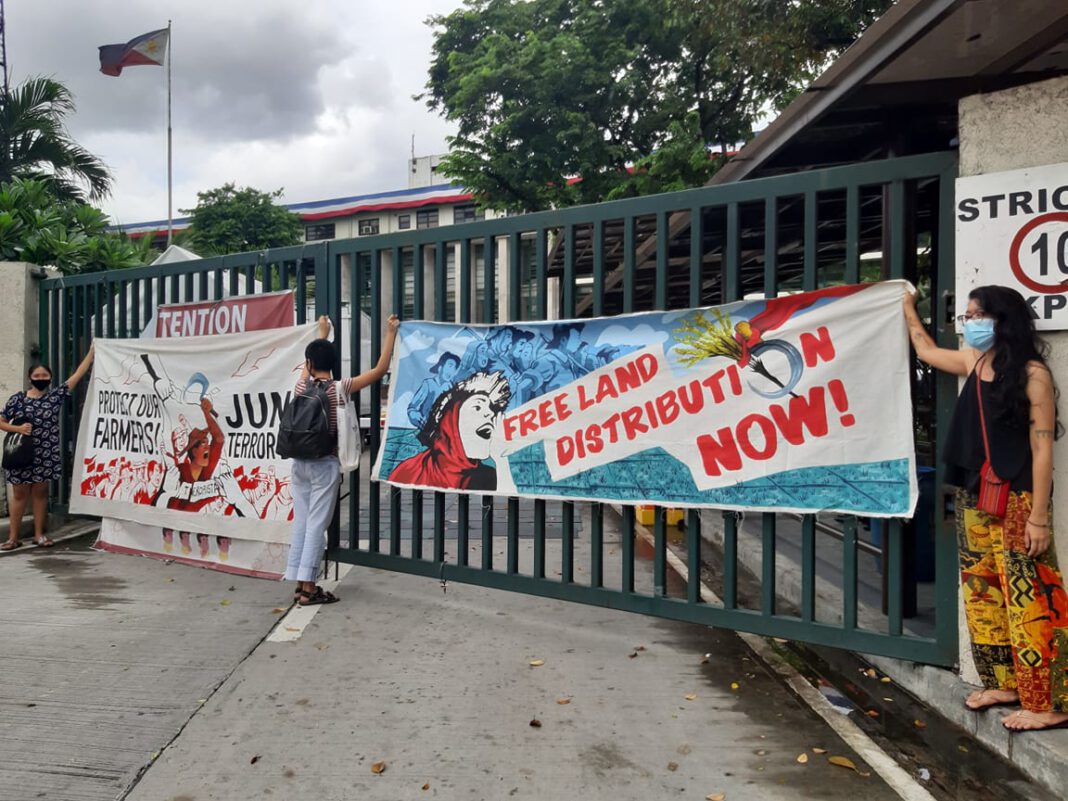Farmers, land reform advocates, and peasant groups trooped to the Department of Agriculture (DA) in Quezon City for a lightning protest on the 32nd year of the Comprehensive Agrarian Reform Law.
“After 32 years of CARP, 7 out of 10 farmers remain landless. Many have joined our ranks of agriworkers and farmworkers who continue to suffer this injustice. Many have shed blood fighting for it,” said Unyon ng mga Manggagawa sa Agrikultura (UMA) Chairperson Antonio “Ka Tonying” Flores.
The Comprehensive Agrarian Reform Law was enacted on June 10, 1988, under the administration of late president Corazon Cojuangco-Aquino, while the program or post-Martial law promise of land reform was known as the Comprehensive Agrarian Reform Program or CARP.
“CARP must be scrapped once and for all, and replaced with a Genuine Agrarian Reform Law. It is high time that actual tillers own the land that they have worked on for decades,” according to Kilusang Magbubukid ng Pilipinas chairperson Danilo Ramos.
The groups also condemned the lack of government aid and support to farmers and agricultural sectors severely affected by the worsening economic crisis and unemployment following the COVID-19 pandemic and more than two months of lockdown.
“Farmers demand for immediate aid, production subsidies, and genuine land reform through free land distribution. These are important and necessary to facilitate rehabilitation and recovery at this time of the pandemic and global crisis. No restriction can stop farmers from protesting and raising our most immediate concerns and demands to the government,” says former Anakpawis Rep. Ariel Casilao.

Agribusiness venture agreements
According to UMA, 4.8 million hectares were said to have been distributed to 2.7 million agrarian reform beneficiaries (ARBs) as of 2019.
However, many of them were forced to enter Agribusiness Venture Arrangements (AVAs) in the form of lease and stock distribution option due to lack of government support.
The lack of support services and subsidy from the government have also driven production costs to skyrocket while prices of produce of farmers remain at the mercy of traders forcing them to illegally sell the lands or enter into lease agreements. This has allowed agribusiness plantations owned by Dole, Del Monte and Sumifru to expand exponentially, especially in Mindanao.
According to UMA’s local chapter in SOCCSKSARGEN, Dole Philippines has already expanded to 70,000 hectares through AVAs.
Land use conversion
Massive land grabbing is also happening through rapid land-use conversion and used as a loophole of landlords to exempt their lands from CARP. An example of this is Hacienda Roxas in Nasugbu, Batangas, where agrarian reform lands were re-classified as residential or industrial.
Because of this, Hacienda Roxas ARBs also face the destruction of their homes and sugarcane farms because of the impending construction of the Cavite-Tagaytay-Batangas Expressway (CTBEX) under Duterte’s Build-Build-Build Program.
As the country faces rice shortage, vast irrigated rice lands in Brgy. Bunducan and Brgy. Putat in Nasugbu have been illegally converted by Sen. Cynthia Villar “using dummies” to expand Camella Homes, assailed UMA.
Peasants killed even before ‘terror bill’
“Under Duterte, more than 250 agri-workers and farmers fighting for their lands were killed, while thousands were murdered in his fake war on drugs and Marawi Siege,” said Flores.
He said the number does not include the illegal arrests, intense military operations and community bombings that have traumatized women and children.
During the COVID-19 lockdown from March 12 to May 31, at least three peasant leaders who reported to have been red-tagged or harassed by the military were killed. They were Nora Apique from Surigao del Sur, John Farochilin from Iloilo, Allan “Mano Boy” Aguilando from Northern Samar.
“Isn’t this the doing of a terrorist? Why should we allow a terrorist to lead our country? If we want to end this pandemic, if we want what is good for our food frontliners, there is no other answer but to seek for this tyrant’s ouster,” said Flores.
Neglect during pandemic
“To make matters worse, food frontliners, such as agriworkers and farmers, have been neglected as the country faces the pandemic. The DA did not even provide cash assistance and production subsidy for agri-workers and farmers growing other crops besides rice,” said Flores.
In the DA’s P51-billion Plant, Plant, Plant program, a mere P3 billion was earmarked for social amelioration of farmers and fisherfolks, excluding agri-workers, who have also experienced work stoppage and reduced work days during the pandemic.
“This is why we are protesting and demanding P10,000 cash assistance, P15,000 production and wage subsidy, and free mass testing and treatment for agri-workers and other food frontliners. Does this make us terrorists?,” asked Flores.
Genuine agrarian reform
Casilao filed House Bill 555 or the proposed Genuine Agrarian Reform Bill (GARB) would be a holistic approach to resolve the landlessness problem of poor Filipino farmers in the countryside on July 2017.
The main goal of GARB is to distribute the agricultural lands to the farmers at no cost to the beneficiaries. Compensation to landowners to be shouldered by the state.
Peasant groups have long asserted that the the continuing land monopoly and control of a few landlord families shows that the CARP is bogus and has failed. It was unable and not meant to break land monopoly and was instead implemented only to appease peasant unrest in the countryside, that the groups said was “a classic counter-insurgency stratagem to create an illusion of land reform.” Casilao has said land monopoly is the root cause of armed uprising of the peasants, primarily embodied by the New People’s Army.
The “bungkalan” (cultivation) campaigns of farmers across the country have also tried to remedy the landlessness and hunger of farmers, but could only do so much, as they can be harassed or killed as what happened to the Sagay 9 in Negros Occidental.
The third round of peace talks between the Government of the Philippines and the National Democratic Front of the Philippines in Rome, Italy in 2017 reached an agreement in principle on “free land distribution.”
The land reform program and problem even reached the next Aquino administration, when Corazon Aquino’s son Benigno Aquino III became president in 2010. The CARP was extended through Comprehensive Agrarian Reform Program Extension with Reforms (CARPER) in 2009 to extend the deadline of land distribution for five years and it expired in 2014. The Department of Agrarian Reform maintained that Notice of Coverage (NOC) may be issued beyond 2014 as contained in the CARPER law.
According to the government, “As of December 31, 2013, the government has acquired and distributed 6.9 million hectares of land, equivalent to 88% of the total land subject to CARP.” Of this area, the Benigno Aquino III administration has distributed a total of 751,514 hectares from July 2010 to December 2013.





























